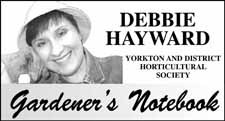When we were digging our yard the other day, we were amazed at the invasive determination of quackgrass. We've all been there: you think you've cleared out a flowerbed, and before you know it, you see the odd tell-tale leaf poking up here and there to let you know that you didn't get every last bit of quackgrass after all! I read somewhere that if the world ever suffered a nuclear disaster, the only thing that would survive are cockroaches. I think we could probably add quackgrass, too!
We always have a little game as we dig: we see who can pull up the longest rhizome of quackgrass. We get some very gratifying examples, thanks to the mulch which doesn't let the plant take firm root in the soil. You know how it feels to pull that long, long root out of the soil! You feel like you're really eradicating your garden of a problem weed!
If you put its peskiness aside, the plant is indeed a great example of adaptation and survival. It has nodes in the rhizomes that send out leaves, so that even if it is cut in one part of the root, the plant can continue to survive. It doesn't need much water to survive, and can grow in all soil conditions. It grows in full sun or shade, and it isn't attacked by any pests or diseases. Why can't our other plants have these attributes?
I did some research about quackgrass. Though it's probably been around for a very long time, the first written account of quackgrass was in 1861. By 1923, quackgrass had worked its way up (or down!) the weed hall of fame to be considered one of the top three worst weeds in Eastern Canada. It grows in every province, and it is estimated that 44 million acres, or 56% of Canadian farmland has quackgrass.
Here's a little factoid that you have to read twice: it is reported that one quackgrass plant produced 154 metres of rhizomes and 206 shoots. 154 metres! That's almost 500 feet! That's amazing!
This sturdy plant also has negative economic impact, because it can absorb an average of 53% of the nitrogen, phosphorous and potassium available for plant use. That means decreased production. It also acts as a host for a variety of pests, which can add to the problem even more.
And how do we get rid of quackgrass? You can use herbicide; or if you would rather not use chemicals, you can try to dig it out. But after all I have read, it seems that quackgrass will always be with us, if not on the surface, then lurking in the background! It's one of those challenges that gardeners will always face!
The next meeting of the Yorkton and District Horticultural Society will be on Wednesday, June 16. We will be having a tour of Skinner Garden Classics, plus other fun events. Call Liz at 782-2830 for all the details.
And if you'd like to have a mini gardener's getaway, the SHA Annual Bus Tour, July 13 - 15, might be for you! Tour gardens and interesting sights in the south-west corner of the province. All you have to do is get on the bus, relax, and enjoy the tour! Call Glen at 783-7040 for details on the bus tour.
Till next time, have a good week, watch out for that quackgrass, and if you're working outside, be sure to wear a hat!




